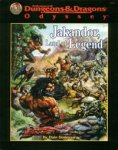Shade
Monster Junkie
This thread continues the idea of “cooperative conversions”, converting a series of monsters from similar sources. For this thread, we will be focusing on monsters that first appeared in the assorted campaign settings not covered by other threads, such as Jakandor, Birthright, Ravenloft, etc.
What I will do is first post the creature’s original stats and flavor text. Then, I will post a basic outline of the things I think it needs, and then I will give you an opportunity to suggest stats and ideas on how powers and abilities should work. Then, I will add more to it and we will continue to discuss it until I feel it’s done and time to move on to the next. As we work on these creatures, they will be posted in this thread, and after 10 conversions are complete they will be added to the Creature Catalog. You may comment on monsters already finished, of course.
What I will do is first post the creature’s original stats and flavor text. Then, I will post a basic outline of the things I think it needs, and then I will give you an opportunity to suggest stats and ideas on how powers and abilities should work. Then, I will add more to it and we will continue to discuss it until I feel it’s done and time to move on to the next. As we work on these creatures, they will be posted in this thread, and after 10 conversions are complete they will be added to the Creature Catalog. You may comment on monsters already finished, of course.
Last edited:





